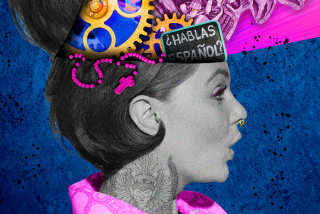Book review: ‘Is That a Fish in Your Ear?’
- Share via
Is That a Fish in Your Ear?
Translation and the Meaning of Everything
David Bellos
Faber & Faber: 384 pp, $27
When it was announced that the 2011 Nobel Prize in literature was going to Tomas Tranströmer, Americans could be forgiven for not immediately recognizing the name of the 80-year-old Swedish poet. His most recent U.S. books come from two niche independent presses — New Directions and Green Integer — and his only collection with a major American publisher is out of print (Ecco, a division of HarperCollins, has announced it will be reissued). Despite globalization, Americans consume a particularly small quantity of literature from other places and tongues; the river of translation flows outward from English into other languages.
How that came to pass, its effects and the mechanisms of translation itself are the focus of “Is That a Fish in Your Ear?” by David Bellos. This informed book props open the door to the idea of translation with pop culture, taking its title from the science fiction novel “The Hitchhiker’s Guide to the Galaxy.” In that book, author Douglas Adams imagined a fish that when dropped in a person’s ear rendered every language instantly intelligible; he called it a Babel fish.
Babel, of course, comes from the Bible’s story about the Earth’s people being scattered and a single language being confounded into many. That count is currently, Bellos tells us, about 7,000 — an enormous number considering that the most highly skilled linguists have claimed to master 50 languages. People in the most multilingual cultures max out between five and 10 languages. How on earth do we talk to each other?
Through translators, of course. Bellos is an award-winning British-born translator of French literature and the director of the Program in Translation and Intercultural Communication at Princeton. This broad-ranging book reads like a survey course in translation, providing a look at its history, detractors, challenges, future — if computers are the future — and current practice, both spoken and written.
He even uses the word “translation” to demonstrate some of its complexities. “We think that the English term ‘translation’ names something general, of self-evident reality,” he writes. Yet Japan has about two dozen words for different kinds of translation and no all-encompassing umbrella word like ours. And if you’re thinking that’s a lot like the many Eskimo words for snow, not so fast — that was debunked in the 1980s. Think instead, Bellos suggests, of the contemporary American words for coffee.
Other languages employ words such as “turn,” “transmit,” “speak after,” “mouth” and “exchange” where we use “translate” — each of which has its own connotations and metaphors. “Would we have ever thought up the idea of a ‘language barrier,’” Bellos asks, “if our word for translator did not imply something like ‘truck driver’?” Yet he walks an interesting line — while languages are different, he doesn’t see them as insurmountably different. He pulls back from asserting that language radically shapes our mental worlds, describing and dismissing the Sapir-Whorf hypothesis in a few pages.
That’s typical for this book, which keeps moving quickly, stitching together 32 short, idea-packed chapters. A linguistic history of the Bible comes and goes before you can start to wonder about its implications for the religions that see the much-translated work as the word of God. At some points in history, for political and/or justifiable reasons, translators were seen as untrustworthy. Yet when the Nuremberg Trials came along after World War II, aided by emerging 20th-century technology, instantaneous translation — arduous work — became essential and vital to international diplomacy. A look at Google Translate proves it’s very good, because it’s pulling bits and phrases from earlier human translations, but it’s not perfect, nor is it translating from scratch. Correctives are issued: There is no such thing as a “native tongue,” because babies are born without speech; because “literal” is from the Latin word for “letter” and letters are just signs, “literal meaning” is an oxymoron.
The breadth of the inquiry works against its depth: Seminal linguist Ferdinand de Saussure’s early work is tucked into a chapter on international law. Yet when Bellos gives himself space to go micro, the result is arresting. In Chapter 12, he translates a Chinese shunkouliu — a satirical rhythmical quatrain in lines of seven syllables — a dozen ways. These translations, set against one another, illustrate how widely divergent perfectly good matches can be. When it comes to reading Tranströmer in English, then, a reader might find his poems manifest differently in the various English publications.
Currently, 80% of the world’s translated books begin in English and end up as something else; the percentage of foreign-language literary books published in America is just 3%. When Bellos explains how other languages — Sumerian, Greek, Syriac, Latin and French — have also been prominent over time, he seems less concerned about the cultural impact of this imbalance than with the practical one, of not enough skilled translators from diverse backgrounds.
Bellos slowly demonstrates that translation is making choices — at the level of the word and phrase and sentence — which account for tone and meaning and force, understanding both the initial language and the receiving one. He contends that the difference in how we speak comes not from a long-lost single language that has been ripped apart but from a multitude of places and voices that have grown increasingly intermingled. “It is translation,” he writes, “more than speech itself, that provides incontrovertible evidence of the human capacity to think and to communicate thought.”
More to Read
Sign up for our Book Club newsletter
Get the latest news, events and more from the Los Angeles Times Book Club, and help us get L.A. reading and talking.
You may occasionally receive promotional content from the Los Angeles Times.








